Let’s face it. Everybody supports the big clubs. World famous players, huge stadiums, a trophy case full of silverware… But you’re not like that. You don’t like to go with the flow: you listen to your own music instead of what radio stations play, you don’t post what you eat on Instagram, and you didn’t even watched The Squid Game!
Because you want something authentic, we’re suggesting something alternative. Let’s take a trip to one European club full of soul that is always overlooked (and cheap!) Trust us, you won’t regret.
Rayo Vallecano
If you think about Madrid, you’ll probably think of Real Madrid or Atlético de Madrid. But there’s a small neighbourhood in the Spanish capital that breathes differently. Embedded between the streets of Vallecas you’ll find Rayo’s home: Estadio de Vallecas. Or, as they prefer to spell it, Vallekas.
It’s clearly a left-wing oriented club with a blue-collar fanbase. Their supporters define themselves as anti-fascist and proudly show their values in the stands. Rayo has one of the most loyal fanbases, something even more surprising considering they have only experienced brief moments of happiness over its history, mostly promotions to La Liga. The only time they qualified for the Europa League was more than 20 years ago.
The best thing? You can still enjoy the main attractions of Madrid, such as the Prado Museum or the Retiro Park.

Levante
You probably know Valencia and the football team named after the city. But did you know there’s another team in the city? While Valencia CF have conquered domestic and international trophies, Levante has always been a yo-yo team, mostly jumping between first and second division.
They’re known as the Granotas, which means “frogs” in Valencian language. The team used to play in a stadium next to the Turia River back in the 1930s, and that’s when the nickname originated. If you go to the Ciutat de Valencia stadium, don’t forget to say hi to the official mascots, frogs Blau and Grana.

Espanyol
It’s one of Spain’s most historical clubs with a traditional fanbase, but FC Barcelona has always overshadowed them. Espanyol has spent 81 seasons in La Liga, although they rarely fight for the championship. They’ve win the Copa del Rey a few times and have experienced relative success in the Europa League, but always as the underdogs.
Nicknamed Pericos (Parakeets), they currently play at the RCDE Stadium in the municipality of Cornellá. They used to play at the Olympic Stadium built for the Barcelona 1992 Olympic Games, but it was too big and too old. That’s why Espanyol decided to build a new ground. It’s located half an hour away from the city by train and it’s one of Europe’s first eco-friendly stadiums.

Hellas Verona
The biggest upset of the 1985 European football season took place in Italy. Hellas Verona, a club promoted to first division only three years before, surprised everybody and conquered the Serie A title. Bear in mind the 1980s where the golden era of Italian football, featuring superstars like Maradona and Platini. A couple years after the feat, the team went back to its usual fight to avoid relegation.
We know you’re a person who loves culture. That’s why we recommend you go to Verona. It’s the city where Shakespeare’s play Romeo and Juliet is set. And if you are into history, it’s worth mentioning that the Roman amphitheatre located in the city centre and it is the second biggest in Italy, right after Rome’s Coliseum. Large-scale operas are performed there, so that’s also a good excuse to visit Verona!

Torino
Juventus might be Italy’s biggest club, but Torino equals (and even surpasses!) that popularity in Turin. Unlike ‘La Vecchia Signora’, Torino rarely fights for silverware. But things were different a long time ago. Torino became one of the best teams in the world during the 1940s, when they conquered four league titles in a row. The team was killed in an air accident, but it’s still remembered and loved.
Besides football, Turin has lots of cultural attractions to upgrade your trip. It was the birthplace of cinema, so you can find a museum devoted to its history. And given its history as an industrial city, don’t forget to visit the automobile museum located 3km near Torino’s stadium.

Fulham
If you like old-school stadiums, you can’t leave London without visiting Craven Cottage. Built in 1896, their wooden-made grandstand will give you a taste of what football used to be like in its early days. The stadium was erected next to the River Thames, so watching a Fulham FC match becomes a truly British experience.
Fulham hasn’t spent as many seasons in the Premier League as the other big London clubs, but it reached the Europa League final in 2010. It’s a team that struggles to remain in the first division, but who cares when you have one of England’s most beautiful homes?

Watford
Fun fact: back in the 1970s, Elton John became the chairman of the club. Back then, Watford was a very small club trying to return to Third Division, but within a few years, the Hornets got promoted to First Division. They eventually were relegated to second tier, but at least their bottom was higher now. They’re back in the Premier League now, fighting to stay afloat one more season.
Watford play in Vicarage Road, a century-old stadium renovated five years ago, when the team was back again in the top flight. It’s located 1 hour away from Central London, a reasonable distance that gives you time to explore the big city!

Southampton
Tired of English biggest cities? Then try something different in Southampton. It’s a coastal city located in the south of England, with one of the most important ports of the country. It was the city where the famous Titanic sailed away to the United States.
And of course, it’s the home of Southampton FC. The Saints are one of England’s oldest clubs, although they never reached the Premier League until 1960s, where they’ve played regularly with a few brief spells at the second level. They play at St. Mary’s Stadium, built in 2001 with a capacity of 32,000 spectators.


